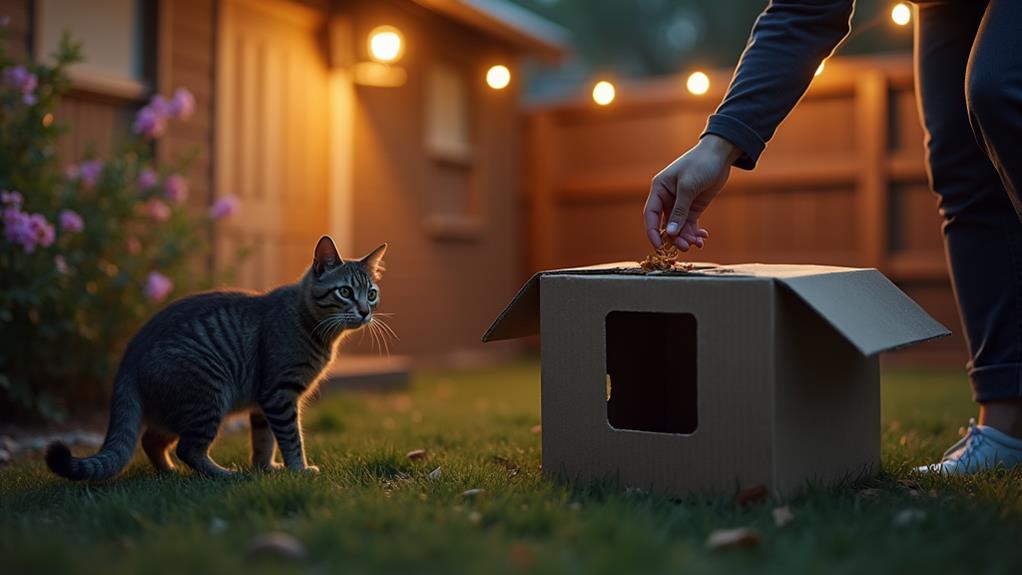How to Catch a Feral Cat Without a Trap: Effective and Humane Methods

To catch a feral cat without a trap, start by gradually building trust. Consistently feed the cat near its usual spot, using strong-smelling foods like canned fish. Speak softly and move slowly to create a calming atmosphere. Set a food trail guiding the cat to an enclosed, quiet space, and have a partner assist if possible. Once inside, cover the cat gently with a blanket to reduce stress. Wear gloves to stay safe from bites or scratches during handling. After capture, guarantee a direct trip to the vet for a health check. Uncover more thoughtful techniques for humane cat capture.
Understanding Feral Cat Behavior
To effectively catch a feral cat without a trap, it's vital to understand their behavior. Feral cats are typically hard to catch because they're naturally wary of human contact. Their behavior is shaped by a strong instinct for self-preservation, leading them to exhibit immediate flight responses when approached. You'll often find them hiding in safe, secluded areas within their territory, making them elusive targets.
Understanding feral cats means recognizing their colony dynamics. These cats tend to form colonies and establish routines, offering you valuable insights into their habits. By observing their behavior, you can identify patterns and potential opportunities for humane methods of catching them. Recognizing their body language is significant; for instance, flattened ears or arched backs indicate heightened stress levels and a readiness to flee.
Unlike stray cats, feral cats don't vocalize much, so don't expect meows for attention. Instead, focus on their subtle cues to understand their stress levels and predict reactions. By patiently observing their behavior, you'll gain the understanding needed to approach them thoughtfully and effectively. With this knowledge, you can reduce their stress and improve your chances of a successful, humane capture.
Building Trust Gradually
Having gained insight into feral cat behavior, you can now focus on building trust gradually. Start by introducing food near the cat's regular feeding area. This creates a sense of safety and encourages the cat to approach more frequently. Consistency is key, so make sure to feed the cat at the same time every day. This establishes a routine, showing the cat that you're a reliable food source.
To foster a trusting relationship, maintain a calming demeanor when you're nearby. Speak softly and move slowly to reduce any anxiety the cat might feel. Allow the cat to initiate contact on its own terms. Don't force interaction, as this could break the fragile trust you're working to build. Patience is crucial; it might take several weeks for the cat to feel secure enough to come near.
Here are some tips to remember:
- Introduce food gradually: Place it near their regular feeding area.
- Be consistent: Feed at the same time each day.
- Stay calm: Use a soothing voice and gentle movements.
- Let them lead: Allow the cat to approach when it feels ready.
Building trust is a slow process, but your patience will pay off.
Safe Capture Techniques

Capturing a feral cat without a traditional trap requires careful planning and a gentle approach. Using safe capture techniques, start by coaxing the cat into an enclosed space, like a large carrier or an improvised enclosure. Create a food trail leading to this space, confirming it's quiet and secure to lessen the cat's anxiety. This method gradually guides the cat to a place where it feels safe and more willing to enter the carrier.
When dealing with a skittish cat, maintain a calm demeanor. Approach slowly and quietly, using quickness and dexterity to secure the cat without causing harm. A towel or blanket can be invaluable once the cat is captured. Covering the cat with a towel or blanket helps minimize stress and prevents escape during handling, adding a layer of protection for both you and the cat.
Having a partner can be beneficial during the capture process. Confirm both of you remain calm and coordinated, as this greatly reduces the risk of overwhelming the cat with anxiety. Remember, the goal is to make the process as humane as possible, prioritizing the well-being of the cat at every step.
Using Natural Lures
When you're looking to catch a feral cat without a trap, natural lures can work wonders. Utilizing strong-smelling foods like canned fish or chicken, you can attract feral cats to a designated area. These scents are hard for a cat to resist and can lead them towards a humane capture. Set up a food trail that guides the cat into an enclosed space, such as a large carrier. This method allows cautious cats to follow the aroma and enter for a meal.
To increase your chances, consider these tips:
- Use familiar sounds: Play recordings of meowing or kitten cries to draw feral cats closer.
- Create a cozy space: Set up blankets or towels in the enclosed area to offer a safe environment.
- Observe the feeding routine: Time your efforts around the cat's usual feeding schedule to make them feel secure.
- Choose the right location: Pick a quiet area where the cat feels at ease to encourage them to approach.
Handling With Care

Once you've successfully lured a feral cat into an enclosed space, it's important to handle the situation with care. Start by putting on gloves to protect yourself from potential bites or scratches, as feral cats often react defensively when approached. Approach the cat slowly and calmly; sudden movements can increase its stress and fear, risking an escape attempt.
Once you're close enough, gently place a towel or blanket over the cat. This step is significant—it helps calm the cat and minimizes the risk of injury to both you and the animal. Make sure you've prepared a secure area for transporting the cat. This space should be escape-proof and designed to reduce anxiety during transport.
After securing the cat, monitor its behavior closely. Look for any signs of distress or illness, and make a point to schedule a veterinary check-up as soon as possible. This step is essential for evaluating the cat's health and guaranteeing a humane approach to its care. By handling the situation with patience and attention to detail, you increase the chances of a successful and humane capture.
Post-Capture Considerations
Successfully securing a feral cat is just the beginning of a fundamental process aimed at guaranteeing its wellbeing. Once captured, it's imperative to transport the cat directly to a veterinarian. This immediate step allows for a thorough health assessment, including checking for injuries or illnesses. Scheduling spaying or neutering is crucial, as it plays a significant role in managing feral and community cat populations sustainably.
During the waiting period at the vet, keep a close watch for signs of stress or illness. Feral cats may show unusual behaviors when confined, so monitoring is key. Once the veterinary procedures are complete, provide the cat with a secure, quiet space to acclimate. Reducing noise and disruptions can greatly lower the animal's anxiety levels.
Consider these post-capture steps:
- Transport directly to a veterinarian for health assessment
- Schedule spaying or neutering to manage populations
- Monitor signs of stress or illness during confinement
- Acclimate the cat in a quiet, secure space post-treatment
Long-term, participate in a TNR program to guarantee the cat's wellbeing and contribute to reducing the overall community cat population. Follow all post-neuter care recommendations to support a smooth recovery.




